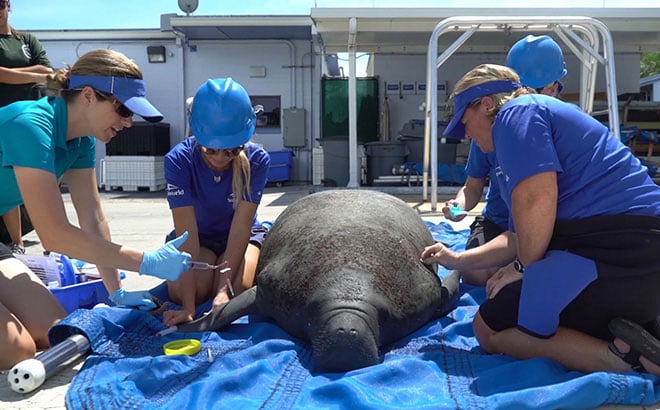SeaWorld and Local Partners Brace for Spike in Red Tide Rescues
August 10, 2018
The SeaWorld Rescue team helps a male manatee to breath in fresh air to assist in reversing the effects of red tide at the SeaWorld Orlando Manatee Rehabilitation critical care facility.
Florida’s recent bloom of toxic red tide algae has overwhelmed the state’s southwestern coast, putting marine animals in grave danger. As frequent algae eaters, Florida’s manatee population is particularly susceptible to the toxins found in red tide, which is why our rescue team is working around the clock with the Florida Fish and Wildlife Conservation Commission (FWC) and the Manatee Rescue & Rehabilitation Partnership (MRP) to rescue and treat affected manatees, with the ultimate hope to return these animals to the wild.
According to a recent report by the FWC, Florida’s Cape Coral, Lee County, and Charlotte County have been identified as the region’s current hot zones for red tide, with algae blooms predicted to continue into 2019. Consuming red tide puts manatees at an increased risk for drowning, causing them to fall into a near comatose state that prevents them from swimming or even being able to lift their heads above water. However, if an animal is rescued and treated within 24 hours of consuming the toxin, it is likely to make a complete recovery.
Together with partners from the FWC and MRP, the SeaWorld Rescue team has taken in 10 manatees and counting affected by red tide, treating them at SeaWorld’s critical care facilities, while readying supplies and equipment for red tide related rescues and treatment in the coming months. As one of three federally permitted manatee rehabilitation facilities, SeaWorld is treating the most critical cases inside our specially designed med pools, with rescue teams providing around the clock care and using foam pillows to prop manatees’ heads above water so they can breathe in fresh oxygen to ensure a speedy recover. After intensive treatment with SeaWorld, manatees requiring continued care are relocated by the Manatee Rescue & Rehabilitation Partnership (MRP) to other local facilities to continue their recovery.
SeaWorld Orlando has used med pools to care for more than 46 critical manatee rescue cases in the past year alone, including Lagoona—a young manatee with one of the most severe injuries our experts had ever seen— and four manatee calves, who were all released after intensive treatment and rehabilitation. Throughout its history, SeaWorld has rescued more than 670 manatees.
Florida’s recent bloom of toxic red tide algae has overwhelmed the state’s southwestern coast, putting marine animals in grave danger. As frequent algae eaters, Florida’s manatee population is particularly susceptible to the toxins found in red tide, which is why our rescue team is working around the clock with the Florida Fish and Wildlife Conservation Commission (FWC) and the Manatee Rescue & Rehabilitation Partnership (MRP) to rescue and treat affected manatees, with the ultimate hope to return these animals to the wild.
According to a recent report by the FWC, Florida’s Cape Coral, Lee County, and Charlotte County have been identified as the region’s current hot zones for red tide, with algae blooms predicted to continue into 2019. Consuming red tide puts manatees at an increased risk for drowning, causing them to fall into a near comatose state that prevents them from swimming or even being able to lift their heads above water. However, if an animal is rescued and treated within 24 hours of consuming the toxin, it is likely to make a complete recovery.
Together with partners from the FWC and MRP, the SeaWorld Rescue team has taken in 10 manatees and counting affected by red tide, treating them at SeaWorld’s critical care facilities, while readying supplies and equipment for red tide related rescues and treatment in the coming months. As one of three federally permitted manatee rehabilitation facilities, SeaWorld is treating the most critical cases inside our specially designed med pools, with rescue teams providing around the clock care and using foam pillows to prop manatees’ heads above water so they can breathe in fresh oxygen to ensure a speedy recover. After intensive treatment with SeaWorld, manatees requiring continued care are relocated by the Manatee Rescue & Rehabilitation Partnership (MRP) to other local facilities to continue their recovery.
SeaWorld Orlando has used med pools to care for more than 46 critical manatee rescue cases in the past year alone, including Lagoona—a young manatee with one of the most severe injuries our experts had ever seen— and four manatee calves, who were all released after intensive treatment and rehabilitation. Throughout its history, SeaWorld has rescued more than 670 manatees.

How You Can Help Save Manatees
SeaWorld’s Rescue Team is the first responder to marine animals in distress, and we are available all day, every day. If you see a suffering manatee in a red tide area, call the FWC Wildlife Alert Hotline immediately at 1-888-404-FWCC (3922) or contact [email protected].
We also encourage you to learn more about our work, our partners and how we can all help this species at SeaWorld’s Manatee Rehabilitation Area, where guests can experience behind-the-scenes rehabilitation work firsthand.


